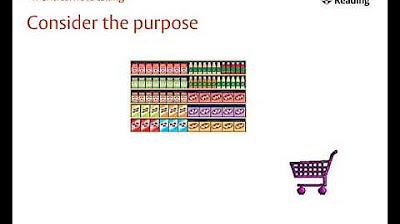Untitled: Apr 2, 2023 12:25 PM
Summary
TLDRThis video teaches effective note-taking and quiz preparation techniques using a digital textbook. The presenter walks through a methodical approach: reading chapters lightly, then slowly and carefully, followed by answering quiz questions based on textbook content. Key concepts such as essential and non-essential nutrients are explained, including the idea of conditionally essential nutrients. The video also demonstrates how to apply the process of elimination to multiple-choice quiz questions, helping viewers understand material more deeply and improve their quiz scores.
Takeaways
- 😀 Begin reading a chapter lightly, as if reading casually while waiting in a line, to get a general overview of the material.
- 😀 The second read-through should be more focused and slow, paying close attention to the details and understanding the content word by word.
- 😀 After reading, review the quiz questions and use the textbook to find relevant information to answer them.
- 😀 Non-essential nutrients are those that the body can produce in the required amounts, so you don't necessarily need to obtain them from food.
- 😀 A non-essential nutrient may become essential in certain conditions, such as during illness or for babies who cannot produce certain nutrients.
- 😀 The concept of conditionally essential nutrients refers to nutrients that are not normally essential but must be obtained from the diet under specific circumstances.
- 😀 Examples of conditionally essential nutrients include certain lipids needed by older children and adults, which babies cannot synthesize on their own.
- 😀 Essential nutrients must be obtained from the diet because the body either cannot produce them at all or cannot produce them in the necessary amounts.
- 😀 The body does not store non-essential nutrients in significant amounts, as they can be synthesized when needed.
- 😀 Through a process of elimination, the correct answers to quiz questions can often be found by eliminating obviously incorrect options and focusing on the most accurate information.
- 😀 By following the reading and note-taking process outlined in the video, you can better prepare for quizzes and improve your academic performance.
Q & A
What is the first step in reading a chapter according to the video?
-The first step is to read the chapter lightly, as if you're casually reading a magazine while waiting in line at a grocery store.
What should you do after reading the chapter lightly?
-After reading the chapter lightly, you should read it slowly and carefully, word for word.
What is the next step after reading the chapter slowly?
-The next step is to look at the quiz questions and search for relevant information in the digital textbook to make notes.
What defines a non-essential nutrient?
-A non-essential nutrient is one that the body can make in the required amount and does not need to consume in the diet.
Can a non-essential nutrient ever become essential?
-Yes, in certain situations such as disease or during specific life stages, a normally non-essential nutrient can become conditionally essential.
Can the body store non-essential nutrients?
-The script does not mention storing non-essential nutrients in the body, suggesting they are not stored.
What is an example of a condition where non-essential nutrients become essential?
-During early life, certain lipids that are normally non-essential become essential for babies who cannot produce them.
What is the role of essential nutrients in the diet?
-Essential nutrients must be obtained from the diet because the body cannot make them in adequate amounts or at all.
How are essential nutrients different from non-essential nutrients?
-Essential nutrients must be consumed through the diet because the body cannot produce them, while non-essential nutrients can be made by the body as needed.
What was the correct answer for the quiz question about non-essential nutrients?
-The correct answer was 'A: Can make in the amount needed,' as non-essential nutrients are produced by the body in adequate amounts.
Outlines

Esta sección está disponible solo para usuarios con suscripción. Por favor, mejora tu plan para acceder a esta parte.
Mejorar ahoraMindmap

Esta sección está disponible solo para usuarios con suscripción. Por favor, mejora tu plan para acceder a esta parte.
Mejorar ahoraKeywords

Esta sección está disponible solo para usuarios con suscripción. Por favor, mejora tu plan para acceder a esta parte.
Mejorar ahoraHighlights

Esta sección está disponible solo para usuarios con suscripción. Por favor, mejora tu plan para acceder a esta parte.
Mejorar ahoraTranscripts

Esta sección está disponible solo para usuarios con suscripción. Por favor, mejora tu plan para acceder a esta parte.
Mejorar ahoraVer Más Videos Relacionados

Study Less Study Smart: A 6-Minute Summary of Marty Lobdell's Lecture - College Info Geek

Consecutive Note Taking-Part 1

How to Read a Textbook - Study Tips - Improve Reading Skills

annotating books will end your doomscrolling 📜

Critical note taking

Compare and Contrast Content of Materials |GRADE 10| MELC-based VIDEO LESSON|QUARTER 1| MODULE 4
5.0 / 5 (0 votes)
